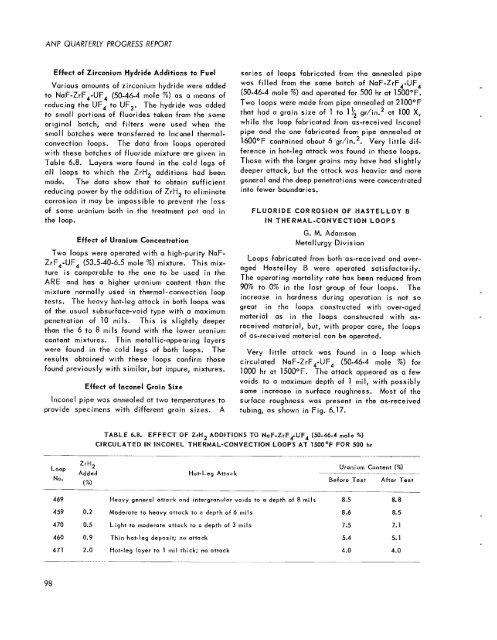ORNL-1771 - Oak Ridge National Laboratory
ORNL-1771 - Oak Ridge National Laboratory
ORNL-1771 - Oak Ridge National Laboratory
You also want an ePaper? Increase the reach of your titles
YUMPU automatically turns print PDFs into web optimized ePapers that Google loves.
ANP QUARTERLY PROGRESS REPOR7<br />
Effect of Zirconium Hydride Additions to Fuel<br />
Various amounts of zirconium hydride were added<br />
to NaF-ZrF,-UF, (50-46-4 mole %) as a means of<br />
reducing the UF, to UF,. The hydride was added<br />
to small portions of fluorides taken from the same<br />
original batch, and filters were used when the<br />
smal I batches were transferred to lnconel thermal-<br />
convection loops. The data from loops operated<br />
with these batches of fluoride mixture are given in<br />
Table 4.8. Layers were found in the cold legs of<br />
all loops to which the ZrH, additions had been<br />
made. The data show that to obtain sufficient<br />
reducing power by the addition of ZrH, to eliminate<br />
corrosion it may be impossible to prevent the loss<br />
of some uranium both in the treatment pot and in<br />
the loop.<br />
Effect of Uranium Concentration<br />
Two loops were operated with a high-purity NaF-<br />
ZrF,-UF, (53.5-40-63 mole %) mixture, This mix-<br />
ture is comparable to the one to be used in the<br />
ARE and has a higher uranium content than the<br />
mixture normally used in thermal-convection loop<br />
tests. The heavy hot-leg attack in both loops was<br />
of the usual subsurface-void type with a maximum<br />
penetration of 10 mils. This is slightly deeper<br />
than the 6 to 8 mils found with the lower uranium<br />
content mixtures. Thin metal lic-appearing loyers<br />
were found in the cold legs of both loops. The<br />
results obtained with these loops confirm those<br />
found previously with similar, but impure, mixtures.<br />
Effect of lnconel Grain Size<br />
lnconel pipe was annealed at two temperatures to<br />
provide specimens with different grain sizes. A<br />
98<br />
Loop<br />
NO.<br />
469<br />
ZrH2<br />
Added<br />
( w<br />
series of loops fabricated from the annealed pipe<br />
was filled from the same batch of NaF-ZrF,-UF,<br />
(50-46-4 mole %) and operated for 500 hr at 1500°F.<br />
Two loops were made from pipe annealed at 2100°F<br />
that had a grain size of 1 to 1\ gr/in., at 100 X,<br />
while the loop fabricated from as-received lnconel<br />
pipe and the one fabricated from pipe annealed at<br />
1600°F contained about 6 gr/in.2. Very little dif-<br />
ference in hot-leg attack was found in these loops.<br />
Those with the larger grains may have had slightly<br />
deeper attack, but the attack was heavier and more<br />
general and the deep penetrations were concentrated<br />
into fewer boundaries.<br />
FLUORlDE CORROSION OF HASTELLOY 6<br />
IN THERMAL-CONVECTION LOOPS<br />
G. M. Adamson<br />
Meta I I urgy Div is ion<br />
Loops fabricated from both as-received and over-<br />
aged Hastelloy B were operated satisfactorily.<br />
The operating mortality rate has been reduced from<br />
90% to 0% in the last group of four loops. The<br />
increase in hardness during operation is not so<br />
great in the loops constructed with over-aged<br />
material as in the loops constructed with as-<br />
received material, but, with proper care, the loops<br />
of as-received material can be operated.<br />
Very little attack was found in a loop which<br />
circulated NaF-ZrF,-UF, (50-46-4 mole %) for<br />
1000 hr at 1500°F. The attack appeared as a few<br />
voids to a maximum depth of 1 mil, with possibly<br />
some increase in surface roughness. Most of the<br />
surface roughness was present in the as-received<br />
tubing, as shown in Fig. 6.17.<br />
TABLE 6.8. EFFECT OF ZrH, ADDITIONS TO NaF-ZrF4-UF4 (50-46-4 male %)<br />
CIRCULATED IN INCONEL THERMAL-CONVECTION LOOPS AT 1H)O"F FOR SO0 hr<br />
Hot-Leg Attack<br />
.~~ .~ ~ _ _<br />
............... ~.~ ..........<br />
Heavy general attack and intergranular voids to a depth of 8 mils<br />
Uranium Content (X)<br />
Before Test After Test<br />
459 0.2 Moderate to heavy attock to a depth of 6 niils 8.6 a. 5<br />
470 0.5 Light to moderate attack to a depth of 3 mils 7.5 7.1<br />
440 0.9 Thin hot-leg deposit; no attack 5.4 5.1<br />
471 2.0 Hot-leg layer to 1 mil thick; no attack 4.0 4.0<br />
___<br />
8.5<br />
a. 8



![Review of Molten Salt Reactor Physics Calculations [Disc 2]](https://img.yumpu.com/21979492/1/190x247/review-of-molten-salt-reactor-physics-calculations-disc-2.jpg?quality=85)













